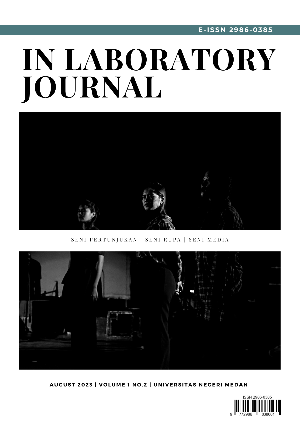Analisis Semiotika Komposisi Musik 4™33™ Karya John Cage
DOI:
https://doi.org/10.24114/ilj.v1i2.50000Abstract
Artikel ini membahas bagaimana karya 433™ John Cage yang banyak dibicarakan oleh khalayak ramai dengan karya fenomenal hanya menghadirkan diam dan tidak ada bunyi yang dihasilkan dari musik yang dimainkan. Dalam hal ini penulis mencoba membahas dari perspektif Semiotika Roland Barthes. Penganalisaan karya tersebut menggunakan metode analisis isi (content analysis) penelitian yang bersifat pembahasan mendalam terhadap isi suatu informasi tertulis atau tercetak dalam media massa. Hasil yang ditemukan dalam artikel ini adaah bagaimana melihat suatu fenomena makna denotasi, makna konotasi dan mitos.References
Andjani, Karina. (2014). Apa Itu Musik? Kajian Tentang Sunyi Dan Bunyi Berdasarkan 433 Karya John Cage. Tanggrang Selatan: CV Marjin Kiri.
Banoe, P. (2003). Kamus Musik. Yogyakarta: Penerbit Kanisius.
Cage, John. (1960). Silence: Lectures And Writings. Hanover: Wesleyan University Press.
Fiske, J. (2007). Cultural and communication studies sebuah pengantar paling komprehensif. Yogyakarta: Jalasutra.
Graham, Gordon. 1997. Phylosophy orf the Arts. London : Routledge.
Greenberg, Clement. (1984). Art And Culture: Critical Essays. Boston: Beacon Press.
Harnia, N. T. (2021). Analisis semiotika makna cinta pada lirik lagu œtak sekedar cinta karya dnanda. Jurnal Metamorfosa, 9(2), 224-238.
Mack, Dieter. (1995). Sejarah Musik Jilid 3. Yogyakrta: Pusat Musik Liturgi.
Mazo, Joseph H. œJohn Cage Quietly Speaks His Piece. œ Bergen Sunday Record. 13 maret 1983.
Pritchett, J. (2009). What silence taught John Cage: The story of 4² 33 ³. The anarchy of silence: John Cage and experimental art, 166-177.
Rader, Melvin. (ed.). (1971). Modern Book Of Aesthetics. New York: Holt, Rinehart & Winston.
Sim, Stuart. (2007). Manifesto for silence. Edinburgh: Edinburgh University Press.
Sobur, A. (2009). Analisis Teks Media Suatu Analisis Untuk Wacana, Analisis Semiotika Dan Analisis Framing. Bandung: PT Remaja Rosdakaarya.
Downloads
Published
How to Cite
Issue
Section
License
Copyright (c) 2023 Ganda Saputra

This work is licensed under a Creative Commons Attribution-NonCommercial-NoDerivatives 4.0 International License.
Copyright of In Laboratory Journal
Copyright for published papers is assigned to the author. The undersigned represents and warrants that the paper is original and that he or she is the author of the paper, except for material clearly identified as the original source, with a notice of permission from the copyright owner where required. The undersigned certifies that the person concerned has the power and authority to make and carry out this assignment.







